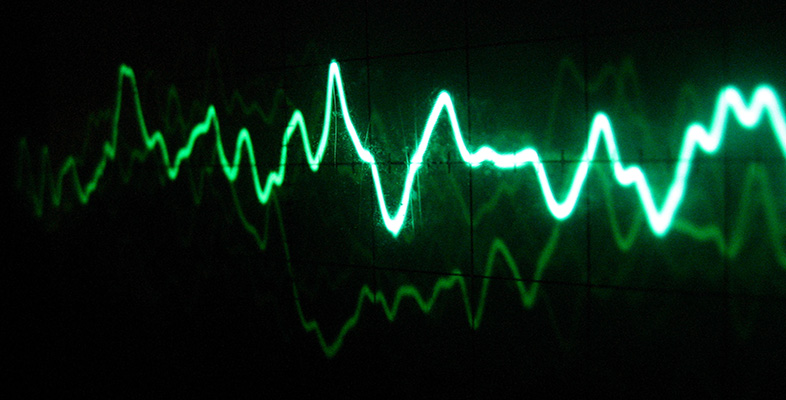1.3 Describing sound
Let's now take a closer look at my list of categories from Activity 3, starting with item (a). In each of my descriptions of this sort, I referred to the source–cause of the sound: that is, an object or an instrument (the source of the sound) and ways of using it to produce a sound (the cause of the sound). Here are other examples of source-cause descriptions:
Violin (source) played pizzicato (cause); pizzicato is a plucking technique for string instruments that are normally played with a bow.
Piano strings (source) struck with a felt-covered hammer (cause); this is the basic mechanism of a modern piano.
Hand (source) clapping (cause); this is central to traditional Spanish flamenco music.
Source–cause descriptions are probably the most common way of describing sounds. Your list probably resembles mine in this respect. Such descriptions are particularly interesting because it is quite remarkable how descriptions of sounds seem to rely so much on things that are not the sounds themselves. Consider the way we would generally describe an object we see. Normally we would describe an object by mentioning a label (let's say, ‘chair’) accompanied by some qualities that, we feel, make the object distinct from others (for example, ‘a wooden, white-painted chair in the corner of the room’). With a verbal explanation, we can characterise the object so that it can be distinguished from other nearby or similar objects. Instead, where sounds are concerned we tend to mention their origins. This sort of description of sounds might be compared to describing objects we see by talking about how they are produced. Perhaps this is because the recognition of the source–causes of sounds is one of the most basic listening abilities – an instinctive ability.
My second category of descriptions (ones that refer to musical elements) is a bit more specific. If you did not have a musical background before you started this unit, you might not have used or mentioned this sort of terminology at all – in the first two tracks, for example, you might have kept your description to the identification of the instrument or instrumental family. You might have been able to add yet more detail (for example, mentioning the types of scale in the first track); you may even have recognised the interval between the two notes in the second track as a minor seventh (or at least, if you did not recognise the interval you should know that, with time, you could work it out). Naturally, the use of musical terminology depends on musical training, but some of the traditional terms have crept into colloquial speech, perhaps due to some form or other of musical training received in early schooling. As you know, ‘note’, ‘key’ and ‘chord’, for example, have specific meanings in music but also have become part of everyday language, as in ‘that strikes a chord’.
My final category, item (c) ‘descriptions that use metaphors’, is a most interesting one, as it relates to a sort of informal language used commonly by musicians and experienced music listeners. (If you want to remind yourself about what a metaphor is, see Box 1.) Qualities like brightness, darkness and depth are commonly attributed to sounds, although these are clearly attributes of things we perceive visually. Interestingly, pitch is supposed to have been originally associated with a metaphor of high/low, which expressed the impression of highness/ lowness of the singing voice. This is still reflected in the physical arrangement of singers in a choir according to their type of voice.
Box 1: Metaphor
According to the Oxford Concise Dictionary, eighth edition (1990), a metaphor is ‘the application of a name or descriptive term or phrase to an object or action to which it is imaginatively but not literally applicable (e.g. a glaring error).’
My three categories have one thing in common. All of them rely on perception: that is, on the sense of hearing. Perceptual categories are most useful and, indeed, necessary because a lot of the sense we make of the world around us is enabled by what we see, hear, smell – that is, generally, perceive. There is no pun intended here: we make a lot of sense of things using our senses. Music technology, in particular, relies much on perception: if the proof of the pudding is in the eating, the ‘proof’ of music technology is in the hearing.
Additionally, though, in technological analyses we need a different way of describing sounds, a way that allows their formal assessment and numerical representation. Essentially, we need to be sure we are talking about the same thing, which is quite difficult to achieve if we rely exclusively on subjective perception. Therefore, a way of approaching sound is borrowed from physics – specifically, from acoustics – and this is the perspective you will be exploring in the remainder of this unit.
In summary, I have used the word ‘sound’ to refer to things that are, indeed, quite different in nature. Sound refers both to what is perceived – a sensation – and to the stimulus that suggests the sensation – a physical phenomenon involving vibrations and energy. It may be a bit perplexing that the same word has such different meanings, and some authors do prefer to use different words. However, in this unit we have decided to stick to one term only, because it is normally quite easy to understand what it refers to from the context in which it appears. The remainder of this unit is a short introduction to the phenomenon of sound: what it is physically, how we quantify it and, at a basic level, how its physical properties are interpreted as sensations.
